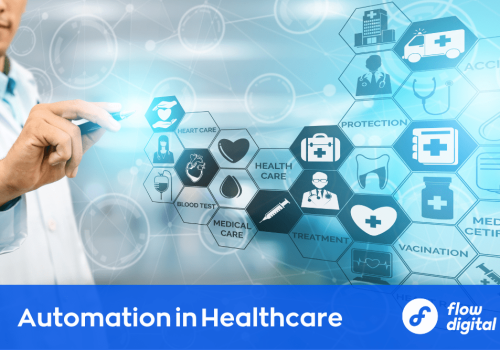In the coming years, it is predicted that 79% of healthcare providers plan to implement automation in the healthcare industry.
Are you wondering how automations can help your facility, and whether they really are worth the hype? Read on to find out why it has become so popular, and how you can enjoy its benefits, too.
Table of Contents:
- Benefits of Automation in the Healthcare Industry
- Automation in Healthcare Examples
- Finding the Right Solution
Benefits of Automation in Healthcare
Automating your healthcare workflow process and patient interactions will help to:
-
Lower costs
Automation generates efficiency. When staff members aren’t overworked due to repetitive technicalities, they are able to accomplish more and boost the facility’s productivity. On top of that, automation in healthcare reduces the risks of human error, which often leads to financial loss.
-
Increase patient satisfaction
A patient’s first interaction with a facility often colors their long term opinion. If they walk in and are met by an overwhelmed receptionist who asks them to wait twenty minutes in order to check in, most likely they won’t be pleased. Automated check-in, scheduling and follow-up reminders create a more efficient and simple patient experience, and doesn’t come at the expense of staff members’ time.
-
Improve diagnosis accuracy
Implementing automations can improve data retrieval, detect mistakes such as prescription errors and produce more accurate diagnosis at a quicker rate. With more precise data, there is a lower chance of malpractice due to diagnostic error and doctors are able to provide better care for patients.
-
Gain valuable employee time
Taking care of repetitive tasks is a given in any healthcare facility – scheduling, registration information, insurance authorization and coding to name a few. When these processes are automated, the risk of staff burnout is decreased and employees are able to focus their time on other important tasks.
-
Advance patient communication
Part of achieving high rates of patient satisfaction and care is the communication between medical staff and their patients. Automation opens up additional channels for patients to get answers to questions and provide important feedback that can help accelerate the recovery process.
A Shared System for Healthcare Automation Solutions
An EHR system, where all patient, scheduling and treatment information are stored, is the first step to implementing automation at your facility. This system should preferably be set up on all devices throughout your facility – or even multiple facilities – so all information can be shared across all exam rooms, nurse’s stations, and offices. This way, doctors, nurses, and patients have access to all patient information, diagnoses, and treatment plans, wherever their location.
Of course, you must take care to ensure that all data, and especially patient information, be shared and stored on systems and technology partners that have proper security certifications and are in compliance with HIPAA and TCPA standards.
Automation in Healthcare Examples
Especially today, while healthcare facilities continue to struggle with severe staffing shortages, these automation ideas can help cut down on repetitive tasks. This can save a lot of valuable time on the job and lessen the effects of being short-staffed.
Here are some examples:
- Appointment Scheduling and Confirmation:
Are there staff members designated specifically for appointment scheduling and confirmation?
You can implement an automated process where almost no patient to staff interaction is necessary for both setting up and confirming appointments.
For appointment setup, advanced scheduling software automations enable patients to schedule their appointments completely on their own. Self-scheduling can take place on any device, at any hour – even while your office is closed – and allows patients to choose their preferred provider, location, and time slot. Of course, both the patient and healthcare staff are notified about the booking.
The next step is confirmation, for which the system automatically alerts patients about upcoming appointments via SMS or email messages. This is both convenient for patients and time-saving for facility staff who no longer have to reach patients by phone for either scheduling or appointment confirmation.
- Check-In/Check-out Systems
Are front desk receptionists constantly distracted by patients checking in and the required paperwork?
With a self-service system in place, patients are greeted by tablets and have the ability to do the following:
- Sign in for their appointment
- Complete and sign any necessary forms electronically
- Review discharge instructions
- Sign discharge and consent forms
By setting up your system with an automated patient check-in and check-out, the front desk and nursing staff can focus on the other important responsibilities – or even downsize. Furthermore, the removal of constant interruption greatly decreases the chance of human error.
- Patient Portal for Data Access and Transfers
Is your staff manually printing, faxing, or emailing medical forms, test results, and care instructions?
An online patient portal gives practices the option of confidentially and electronically sharing important health details with patients, such as:
- Paperwork required prior to appointments
- Lab results
- Medicine or post-surgical care regimen
Additionally, there are no data privacy concerns involved in printing medical results, paperwork, and care manuals for patients.
- Patient Communications
Is notifying patients of updates and new services a manual and multi-step process?
Suppose your facility would like to automate an email to all patients aged 12 and above, notifying them of the available Covid-19 Vaccine as well as the appropriate hours designated for walk-in patients.
With automation, this could be executed in just a few and simple steps:
- Create an email template for this specific communication
- Export the list of relevant email addresses
- Set the email blast preferences in the email
Stop the data spreadsheet entry, sorting, and exporting. By linking an email service provider with your EHR system, sending communications out to patients becomes a series of clicks rather than steps.
- Virtual Practitioners
Are your nurses and practitioners spending an awful lot of time doing initial exams prior to appointments?
If you are ready to take your technology automation level up a notch, you can join the several hospitals where this is already the practice and have computers collect patient symptoms and vital signs in the exam room.
How it works:
- The patient listens to cues from the ‘computer doctor,’ which collects data from sensors and devices linked to the facility’s system.
- This information automatically uploads to the patient profile and helps the practitioner analyze the patient’s condition and provide a potential diagnosis.
While this can never fully replace a doctor or nurse, this process automation saves a lot of valuable time for healthcare workers, especially since the initial screening can often be the lengthiest part of an exam.
- Diagnostic Tools for Practitioners
Even research and diagnosis of medical conditions can be enhanced by setting up intelligent automations to help doctors reach an accurate diagnosis.
These tools automatically collect and display research and medical studies available based on the symptoms reported by the physician.
Finding the Right Healthcare Automation Solutions
Although implementing automation in your healthcare facility is the obvious solution to many common issues such as provider and staff burnout, increased administrative costs, and inevitable human error, there is a very confusing variety of software and automation options available.
Ready to take this step toward the future of automated healthcare and want to get it right the first time?
With Flow Digital, you can clear the muddle of automation options available and pinpoint the first steps for your facility. As certified experts with Zapier (a powerful automation tool), Flow Digital has helped businesses from a wide range of industries save thousands of hours by improving their workflows.
Get in touch with us today to learn more about healthcare automation solutions.



